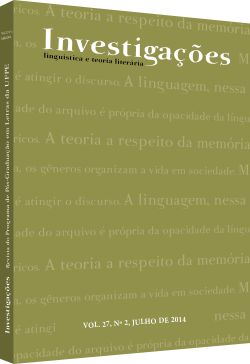Dialogicidade em webaula: um estudo de caso
Resumo
O EaD pressupõe a interação entre professor e aluno, estabelecida, por exemplo, pela webaula, construída com recursos midiáticos, cuja característica essencial é a dialogicidade. Nesse processo, professor e aluno devem ser coautores do processo de construção do texto. O presente artigo analisa, pois, as webaulas como recurso didático do EaD. O objetivo é, em análise fundamentada na embreagem semiótica, refletir se, e como, a dialogicidade é utilizada como ferramenta pedagógica, determinando como elementos da enunciação: actantes, tempo e espaço explicitam a dialogicidade. Espera-se, pois, que o professor consiga construir um texto em que a dialogicidade seja recurso pedagógico.
ABSTRACT
Distance learning is a mode that requires constant interaction between teacher and student. A mode used to establish this interaction is the webclass, which presents dialogism as an essential feature, the capacity to understand the program content in a dynamic way in which teacher and student are co-authors of the text. The present paper examines how courses use the webclass. The objective is to reflect whether, and how, dialogism is used as a pedagogical tool. We carry out an analysis that is based in the semiotics ébreage, it analyzes the elements of the enunciation, actant, time and space that reveal the dialogism.
Keywords: Webclass; Mediated language; Dialogism; Pedagogical mediation
RESUMÉ
L'enseignement à distance implique l'interaction entre le professeur et l'élève, établie par l’webaula intégrée avec des ressources médiatiques, dont la caractéristique essentielle est le dialogisme. Dans ce processus, professeur et élève doivent être co-auteurs de la construction de texte. Cet article analyse les webaulas comme une ressource pédagogique dans L’EaD. L’objectif, basé sur l'analyse sémiotique embrayage, est examiner si la dialogicité est utilisé comme un outil pédagogique, et déterminer comment les éléments de l'énonciation: les actants, le temps et l'espace dialogicité explicite. Il est prévu, par conséquent, que le professeur pourrait construire un texte qui est la ressource d'enseignement dialogique.
Mots clés: Webaula; langue médiatique; dialogicité; médiation pédagogique
Downloads
Publicado
Como Citar
Edição
Seção
Licença
Copyright (c) 2015 Celso Leopoldo Pagnan

Este trabalho está licenciado sob uma licença Creative Commons Attribution 4.0 International License.
Autores que publicam na Revista Investigações concordam com os seguintes termos:
Autores mantêm os direitos autorais e concedem à revista o direito de primeira publicação, com o trabalho simultaneamente licenciado sob a licença Creative Commons Atribuição 4.0 Internacional (CC BY 4.0) que permite o compartilhamento do trabalho com reconhecimento da autoria e publicação inicial nesta revista.
Autores têm autorização para assumir contratos adicionais separadamente, para distribuição não-exclusiva da versão do trabalho publicada nesta revista (exemplo: depositar em repositório institucional ou publicar como capítulo de livro), com reconhecimento de autoria e publicação inicial nesta revista.
Qualquer usuário tem direito de:
Compartilhar — copiar e redistribuir o material em qualquer suporte ou formato para qualquer fim, mesmo que comercial.
Adaptar — remixar, transformar e criar a partir do material para qualquer fim, mesmo que comercial.
O licenciante não pode revogar estes direitos desde que você respeite os termos da licença.
De acordo com os termos seguintes:
Atribuição — Você deve dar o crédito apropriado, prover um link para a licença e indicar se mudanças foram feitas. Você deve fazê-lo em qualquer circunstância razoável, mas de nenhuma maneira que sugira que o licenciante apoia você ou o seu uso.
Sem restrições adicionais — Você não pode aplicar termos jurídicos ou medidas de caráter tecnológico que restrinjam legalmente outros de fazerem algo que a licença permita.

